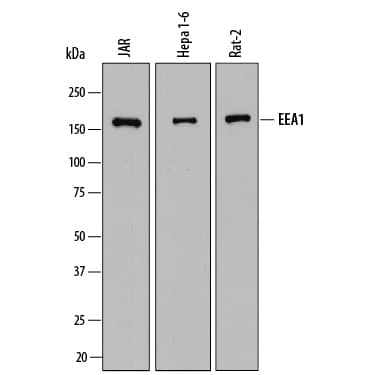Human/Mouse/Rat EEA1 Antibody
R&D Systems, part of Bio-Techne | Catalog # AF8047


Key Product Details
Species Reactivity
Validated:
Cited:
Applications
Validated:
Cited:
Label
Antibody Source
Product Specifications
Immunogen
Asn1249-Gln1356
Accession # Q15075
Specificity
Clonality
Host
Isotype
Scientific Data Images for Human/Mouse/Rat EEA1 Antibody
Detection of Human, Mouse, and Rat EEA1 by Western Blot.
Western blot shows lysates of JAR human choriocarcinoma cell line, Hepa 1-6 mouse hepatoma cell line, and Sheep Anti-Rat-2 rat embryonic fibroblast cell line. PVDF membrane was probed with 1 µg/mL of Sheep Anti-Human/Mouse/Rat EEA1 Antigen Affinity-purified Polyclonal Antibody (Catalog # AF8047) followed by HRP-conjugated Anti-Sheep IgG Secondary Antibody (Catalog # HAF016). A specific band was detected for EEA1 at approximately 170 kDa (as indicated). This experiment was conducted under reducing conditions and using Immunoblot Buffer Group 1.EEA1 in HeLa Human Cell Line.
EEA1 was detected in immersion fixed HeLa human cervical epithelial carcinoma cell line using Sheep Anti-Human/Mouse/Rat EEA1 Antigen Affinity-purified Polyclonal Antibody (Catalog # AF8047) at 1.7 and 5 µg/mL for 3 hours at room temperature. Cells were stained using the NorthernLights™ 557-conjugated Anti-Sheep IgG Secondary Antibody (red; Catalog # NL010) and counterstained with DAPI (blue). Specific staining was localized to early endosomes. View our protocol for Fluorescent ICC Staining of Cells on Coverslips.Applications for Human/Mouse/Rat EEA1 Antibody
Immunocytochemistry
Sample: Immersion fixed HeLa human cervical epithelial carcinoma cell line
Western Blot
Sample: JAR human choriocarcinoma cell line, Hepa 1‑6 mouse hepatoma cell line, and Rat‑2 rat embryonic fibroblast cell line
Formulation, Preparation, and Storage
Purification
Reconstitution
Formulation
Shipping
Stability & Storage
- 12 months from date of receipt, -20 to -70 °C as supplied.
- 1 month, 2 to 8 °C under sterile conditions after reconstitution.
- 6 months, -20 to -70 °C under sterile conditions after reconstitution.
Background: EEA1
EEA1 (Early Endosome Autoantigen 1; also Endosome-associated protein p162 and Zn-finger FYVE domain-containing protein 2) is a 170-180 kDa protein that serves as an identifying marker for early endosomes. It is ubiquitously expressed, and found in both the cytosol and on cellular membranes. Its activity has been described as that of a tethering factor which links endosomes to endocytic vesicles, allowing for their fusion via a SNARE complex. Normally, EEA1 exists as a homodimer in the cytoplasm and appears to make transient contacts with endosome membrane phosphatidylinositol. When endosome fusion is not required, EEA1 serves as a substrate for p97, promoting EEA1 dissociation and endosome independence. When endosome fusion is required, EEA1 interacts with NSF, resulting in its removal from a large endosome-associated complex and subsequent endosomal vesicle fusion. Human EEA1 is synthesized as a 1411 amino acid (aa) protein that contains one C2H2-type Zn finger region (aa 41-64) and one FYVE Zn finger domain (aa 1352-1410). There is one isoform variant that contains a nine aa substitution for aa 925-1411. Over aa 1249-1356, human EEA1 shares 99% aa sequence identity with mouse EEA1.
Long Name
Alternate Names
Gene Symbol
UniProt
Additional EEA1 Products
Product Documents for Human/Mouse/Rat EEA1 Antibody
Product Specific Notices for Human/Mouse/Rat EEA1 Antibody
For research use only
